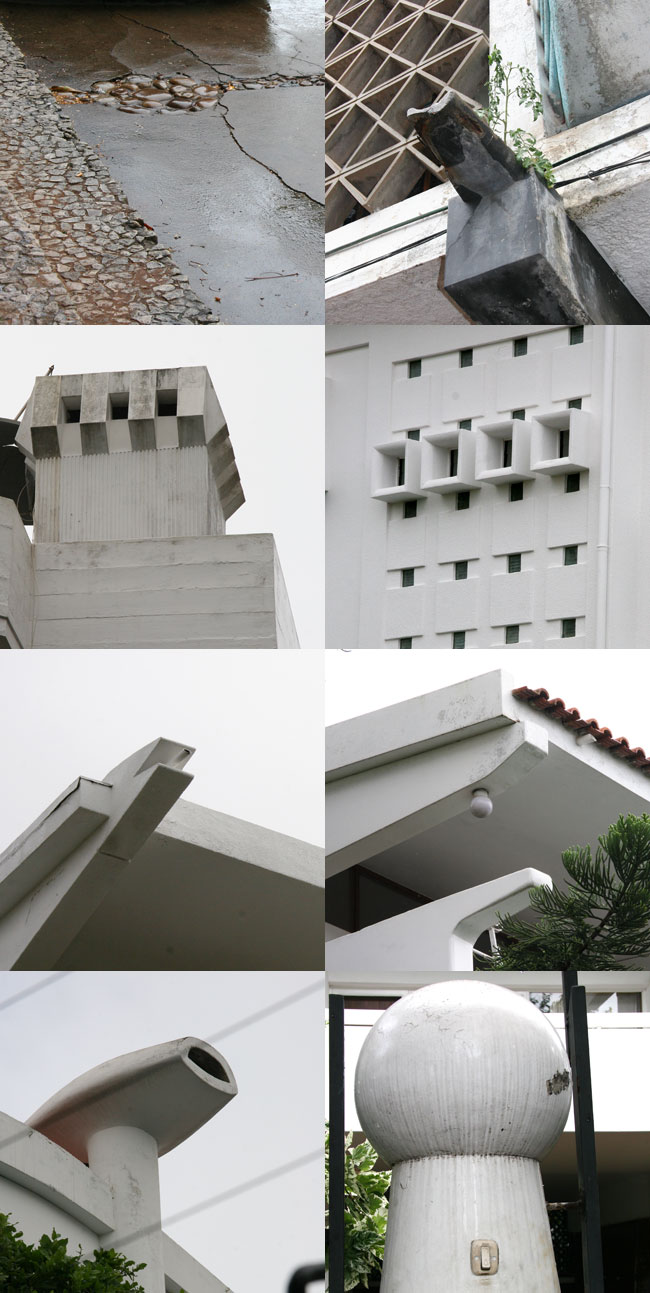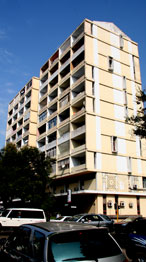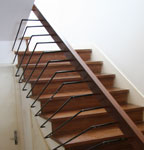PANCHO GUEDES, ARCHITECTURE ON A GRAND SCALE
 A collection of details from my track around Maputo on a nice rainy Sunday morning.
A collection of details from my track around Maputo on a nice rainy Sunday morning.
I went last Sunday on a treasure trail to a number of the buildings designed by Pancho Guedes, the other of the two most famous Portugese architects. I actually live in a great block of flats, (The Tonelli Building) designed by him in a spacious white apartment, on two floors, that many architects would kill for. The building is in a very bad state, the rent is cheap since the water and electricity is in a mess and actually most things other than the form is rather difficult to manage.
 Section through our flat in the Tonelli Building (1954-but uncertain references).
Section through our flat in the Tonelli Building (1954-but uncertain references).
Pancho Guedes (Amancio d’Alpoim Miranda Guedes) will become 85 years old next May 14th. He is a typical Eclectic Modernist and has designed over 500 buildings in Mozambique. He is a true living artist, now living in Johannesburg since the time the Portugese left Mozambique and the real Mozambican took over. He said:
“I claim for architects the rights and liberties that painters and poets have held for so long”
 My Home in Maputo, the Tonelli Building.
My Home in Maputo, the Tonelli Building.
Guedes was born in Portugal but almost all his work is in Africa and mostly in Mozambique. He and was part of the TEAM-X (read Team Ten), a group of architects and other invited participants who assembled starting in July 1953 at the 9th Congress of International Congress of Modern Architecture. This named C.I.A.M was engaged in formalizing the architectural principles of the Modern Movement, but also saw architecture as an economic and political tool that could be used to improve the world through the design of buildings and through urban planning. It was hugely influential during the Fifties and into the Sixties. Team X was an active group from 1960 with the last meeting taking place in Lisbon in 1981. I had become aware of architecture at that time and saw them as a yesterday clan, a common attitude of young people, especially after Post-Modernism started to be part of our world perspective in the early Seventes. Two prominent styles came out of TEAM-X, New-Brutalism (English) and Structuralism (Dutch/German). The style uses function and especially an expression of function as a stylistic method, i.e. they express how the building manages to serve the activites that it is expected to do, both through construction (expressing columns, slabs, cantelevers etc.) and through its services (exposed pipes, ducts etc.). The Smithsons made some pretty cold and brutal projects in the UK, I remember them well from my days in the AA in London, always with style and great attitude. The work of Pancho Guedes includes much of the things based on the theories of TEAM-X, like expression of construction, individuality of function and a kind of a brutal use of materials directly from nature, albeit always under the control of the author: him.
 Apart from this world fame, his creative strength and links to internationally famed architects and artists, I still have some difficulty in admiring. I have no difficulty in admiring the formal exercises, the strength in execution etc. It is the social aspect that makes me uncomfortable. Like the fact that Pancho was part of a group of architects that were basically socialists, or beliefers in social and democratic regulation of architecture and urbanism. Of course history revealed that many of these architects were not so social as we might think: They operated as they were the ones with the only true solutions, the owners of truth about how people should live. The Modernism of the Fifties and Sixties proofed itself to be a total disaster when it came to users: that is us: people. We lived the social disasters in housing with increased depression and rising crime rate in the urbanisms that the architects created.
Apart from this world fame, his creative strength and links to internationally famed architects and artists, I still have some difficulty in admiring. I have no difficulty in admiring the formal exercises, the strength in execution etc. It is the social aspect that makes me uncomfortable. Like the fact that Pancho was part of a group of architects that were basically socialists, or beliefers in social and democratic regulation of architecture and urbanism. Of course history revealed that many of these architects were not so social as we might think: They operated as they were the ones with the only true solutions, the owners of truth about how people should live. The Modernism of the Fifties and Sixties proofed itself to be a total disaster when it came to users: that is us: people. We lived the social disasters in housing with increased depression and rising crime rate in the urbanisms that the architects created.
This is one side, but Pancho Guedes was not really this kind of a Modernist, he was too much of an artist and eclectic. My problems come to the colonial situation he operated in here in Maputo. It is great to see the details in concrete, and for me as an architect I think of the specification and detailing in shuttering etc. needed for these gymnastics in formgiving. But who was the client and who built these projects? My understanding is that the people that made the houses were inumerable black local Mozambicans that had no say in how to run their life, probably not receiving much salary, almost colonial slaves. My reading has been that Apartheit was just as strong in Mozambique as in South Africa, the local people had numbers and had to report that number to the colonial Portugese. The Modernism made by Guedes, like the very beautiful block of flats that I live in at the moment, a symbol of democracy like the Unite Habitation in Marceilles by Le Corbusier, all based on democratic theory for new good housing for the masses, is a fake presentation of architecture.
So, I have to shut my eyes to history and like a proper Modernist, only focus on the form and the formal gymnastics. I remember my fathers comments when he first came to St Petersburg in Russia. My mother was commenting on the beauty of the Winter Palace (Italian Renaissance) and my father said: “I just think of all the slaves that died making this!”
 April 29, 2010
April 29, 2010
 Tags: architecture, CIAM, DESIGN, maputo, mozambique, pancho guedes, TEAM-X Posted in: ARCHITECTURE, DESIGN
Tags: architecture, CIAM, DESIGN, maputo, mozambique, pancho guedes, TEAM-X Posted in: ARCHITECTURE, DESIGN


